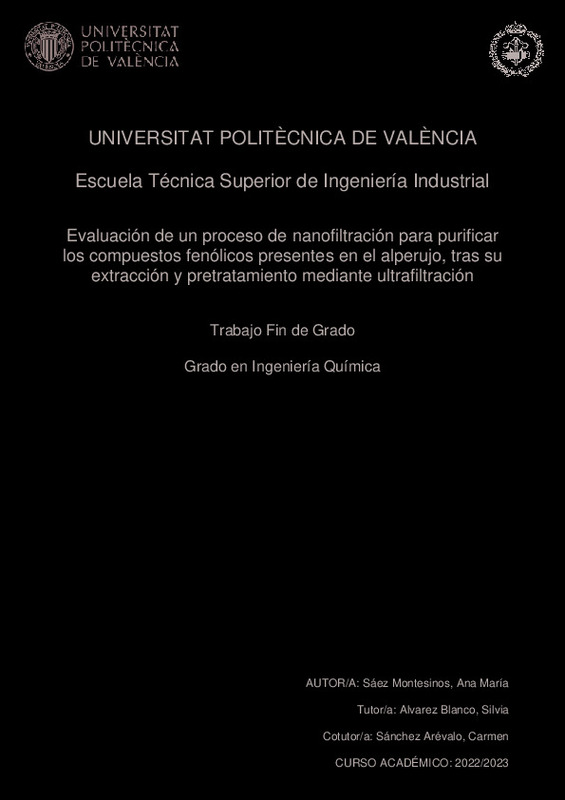|
Resumen:
|
[ES] El alperujo, o ‘’alpeorujo’’, es un resido semisólido procedente de las almazaras, producido
durante el proceso de centrifugación de 2 fases para la elaboración de aceite de oliva. Debido a
su composición fitotóxica ...[+]
[ES] El alperujo, o ‘’alpeorujo’’, es un resido semisólido procedente de las almazaras, producido
durante el proceso de centrifugación de 2 fases para la elaboración de aceite de oliva. Debido a
su composición fitotóxica y ligeramente biodegradable, se trata de uno de los efluentes más
contaminantes del sistema productivo agroalimentario con necesidad de ser tratado.
El alperujo está compuesto por una elevada concentración de polifenoles, con propiedades
antioxidantes, antiinflamatorias y antitrombóticas, entre otras. Gracias a sus beneficios, ha
crecido el interés en recuperar dichas biomoléculas de utilidad industrial con el fin de ser
empleadas en otras industrias como cosmética, biotecnológica, agroalimentaria y farmacéutica.
Por tanto, se propone un proceso de recuperación de estas biomoléculas mediante tres etapas
continuas: en la primera el alperujo se somete a un proceso de extracción sólido-líquido,
seguidamente un proceso de purificación mediante ultrafiltración y, finalmente, un proceso a
concentración mediante nanofiltración.
Es por ello que el objetivo de este Trabajo Fin de Grado consiste en el diseño de una planta de
nanofiltración capaz de procesar una corriente de 96 m3
/día de extracto procedente de la etapa
de ultrafiltración. La planta operará durante 3 meses al año, correspondientes a los meses
operativos de una almazara, y permitirá la comercialización del subproducto enriquecido en
polifenoles.
Previamente al diseño industrial, se ha optimizado el proceso de nanofiltración mediante
diversos ensayos realizados sobre la membrana de nanofiltración NF270 de la casa comercial
DOW FILMTEC. En función de los resultados experimentales obtenidos en el laboratorio, se ha
elegido a nivel industrial la membrana NF270-440, fabricada en poliamida y de arrollamiento en
espiral. Para el diseño industrial son necesarios dos módulos con una superficie activa de 41 m2
.
Por otra parte, del proceso de nanofiltración se obtiene una corriente de rechazo que
corresponde a la que se encuentra concentrada en polifenoles, y otra corriente de permeado
que, debido a su estado de purificación, se puede emplear como un recurso de lavado de otras
superficies, equipos, etc., procedentes de la instalación. Con todo ello, se contribuye a una
economía circular, favoreciendo así el desarrollo de los Objetivos de Desarrollo Sostenible (ODS)
de la Agenda de 2030.
Por último, se ha estudiado la viabilidad económica de la planta industrial. La inversión inicial de
la planta de nanofiltración es de 118.248,42 €, sin embargo, hay que tener en cuenta la inversión
de las etapas anteriores, que ascienden a 11.041.553,22 € (Rojo-Adalid et al., 2021), resultando
un total de 11.159.801,64 €. Los costes totales de explotación son 230.647,40 €, los ingresos
totales 12.235.771,03 €, el beneficio bruto es 12.005.123,03 € y un periodo de recuperación de
la inversión de 1,15 años.
[-]
[EN] The wet olive pomace, or ''alperujo'', is a semi-solid residue from olive oil mills, produced during
the 2-phase centrifugation process, employed for the production of olive oil. Due to its
phytotoxic and low ...[+]
[EN] The wet olive pomace, or ''alperujo'', is a semi-solid residue from olive oil mills, produced during
the 2-phase centrifugation process, employed for the production of olive oil. Due to its
phytotoxic and low biodegradable composition, it is one of the most polluting effluents of the
agri-food production system that needs to be treated.
Therefore, alperujo is composed of a high concentration of polyphenols, with antioxidant, antiinflammatory and antithrombotic properties, among others. Due to its benefits, there has been
a growing interest in recovering these biomolecules of industrial utility, in order to be used in
other industries such as cosmetics, biotechnology, agri-food and pharmaceuticals. Therefore, a
recovery process of these biomolecules is proposed through three continuous stages: in the first
one, the alperujo goes through a solid-liquid extraction process, followed by a purification
process by ultrafiltration and, finally, a concentration process by nanofiltration.
Therefore, the objective of this Final Degree Project is the design of a nanofiltration plant
capable of processing a flow of 96 m3
/day of extract coming from the ultrafiltration stage. The
plant will operate during 3 months per year, corresponding to the operating months of an olive
mill, and will allow the commercialization of the by-product enriched in polyphenols.
Prior to the industrial design, the nanofiltration process has been optimized by means of several
tests carried out on the NF270 nanofiltration membrane from DOW FILMTEC. Based on the
experimental results obtained in the laboratory, the NF270-440 membrane, made of polyamide
and spiral wound, has been chosen for the industrial design. Two modules with an active surface
area of 41 m2
are required for the industrial design.
On the other hand, a rejection stream is obtained from the nanofiltration process, which
corresponds to the one concentrated in polyphenols, and another permeate stream which, due
to its purity, can be used as a washing resource for other surfaces, equipment... coming from
the installation. All this contributes to a circular economy, thus favoring the development of the
Sustainable Development Goals (SDGs) of the 2030 Agenda.
Finally, the economic feasibility of the industrial plant has been studied. The initial investment
of the nanofiltration plant is €118.248,42, however, the investment of the previous stages,
amounting to €11.041.553,22 (Rojo-Adalid et al., 2021), must be taken into account, resulting in
a total of €11.159.801,64. The total operating costs are 230.647,40 €, the total income is
12.235.771,03 €, the gross profit is 12.005.123,03€ and the payback period for the investment
is 1,18 years.
[-]
|







